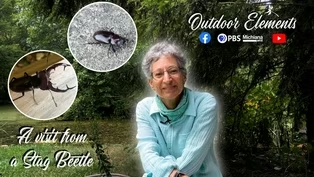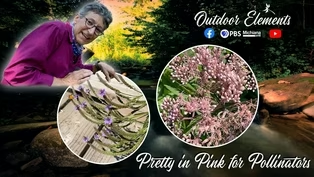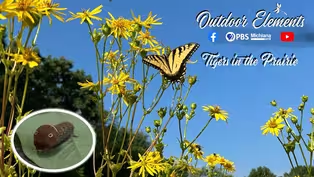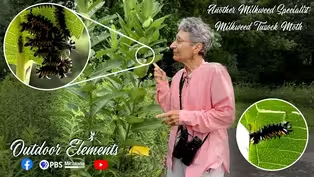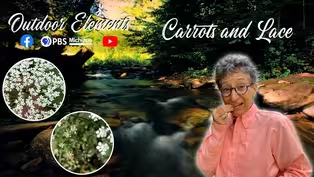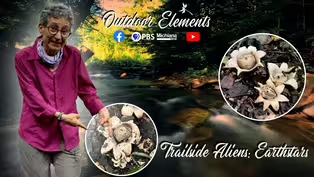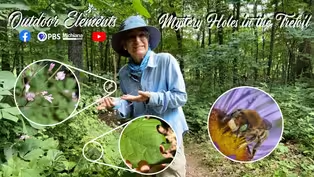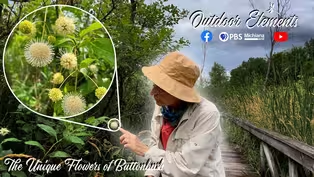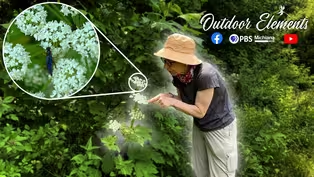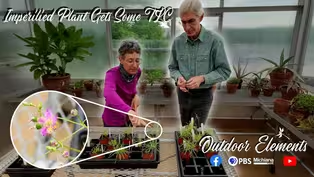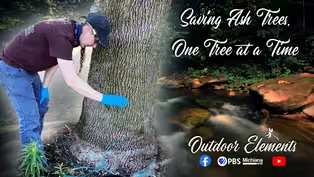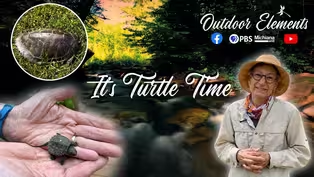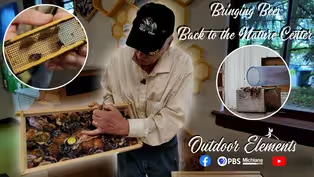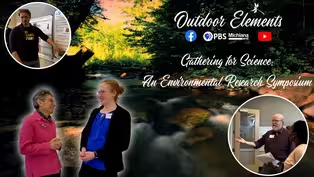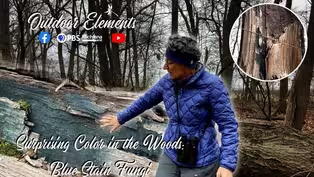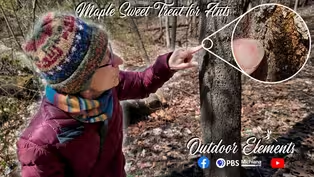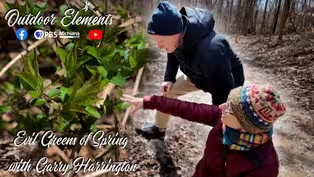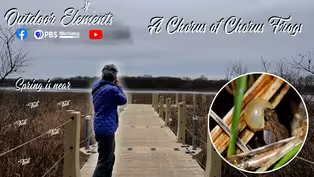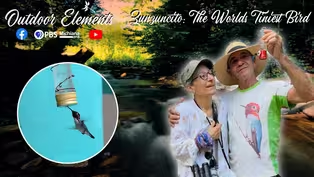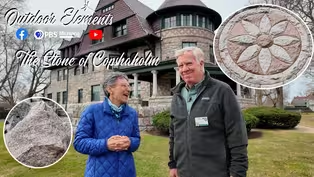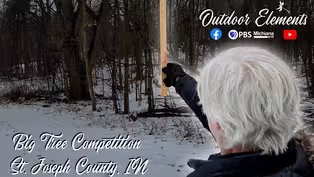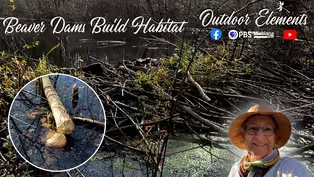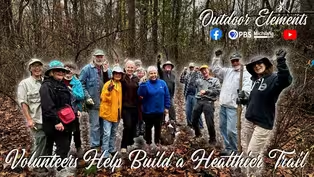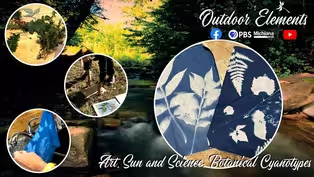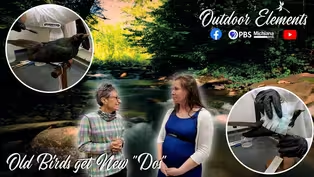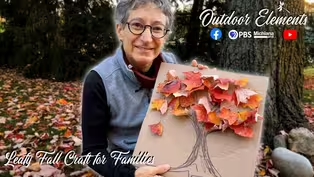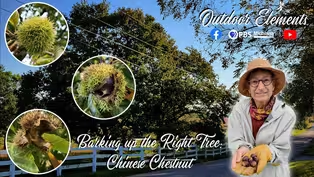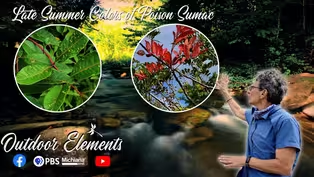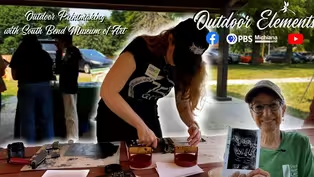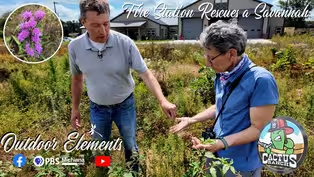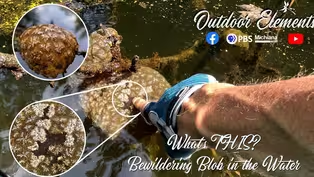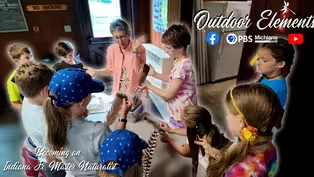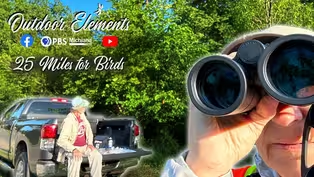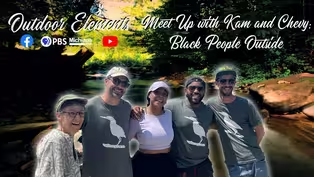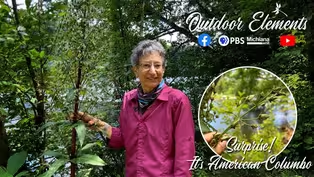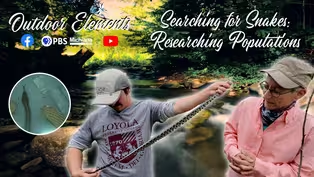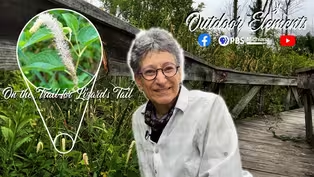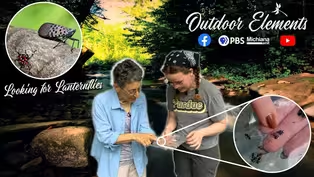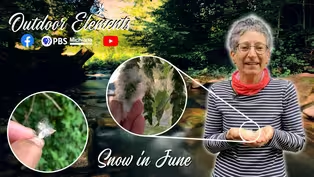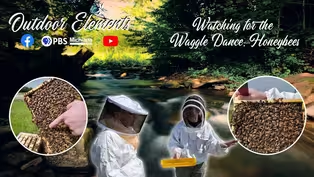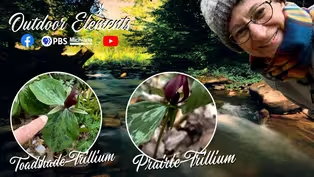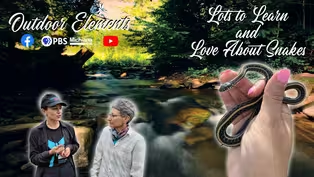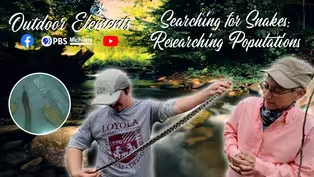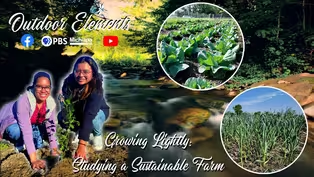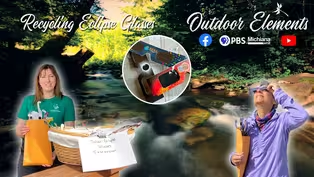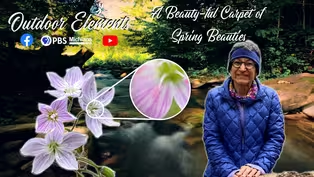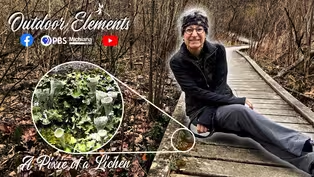Outdoor Elements
Roots and Rhizomes
Clip | 19m 46sVideo has Closed Captions
Roots and root structures do more than supply plants with water. We'll look at different r
Roots and root structures do more than supply plants with water. We'll look at different roots, bulbs and corms and learn about their functions.
Problems playing video? | Closed Captioning Feedback
Problems playing video? | Closed Captioning Feedback
Outdoor Elements is a local public television program presented by PBS Michiana
Outdoor Elements
Roots and Rhizomes
Clip | 19m 46sVideo has Closed Captions
Roots and root structures do more than supply plants with water. We'll look at different roots, bulbs and corms and learn about their functions.
Problems playing video? | Closed Captioning Feedback
How to Watch Outdoor Elements
Outdoor Elements is available to stream on pbs.org and the free PBS App, available on iPhone, Apple TV, Android TV, Android smartphones, Amazon Fire TV, Amazon Fire Tablet, Roku, Samsung Smart TV, and Vizio.
Providing Support for PBS.org
Learn Moreabout PBS online sponsorshipRoots, tubers, rhizomes, corns.
What's the difference?
We're going to find out with Deb Ma.
And Deb is an associate professor in the biology department at IU South Bend and a plant enthusiast, a botanist.
And you've got a spread for us.
We are going to learn all about different kinds of roots, right?
Yeah, I'm excited.
So I'm so excited to go underground and we're going to go underground in several different ways.
Okay.
Well, I guess we should talk about you've got a little looks like a little tulip tree sap.
I have a little tulip tree.
So this is our with a white tree.
And I just wanted to go over the basic so the root structure and then we have this stem which is normally above ground.
And a couple of things that I want you to notice about the roots.
So roots have a different structure than stems.
So in the roots at the tips, they have root caps that allow them to sense their environment, move through the soil.
And also if we cut through the roots, the vascular tissues, so the xylem and phloem, how they carry water and nutrients through the plant is different.
Now, if we go above ground, notice that in the stem we have this pattern of no leaves, leaf no leaves.
So we call that internode node enter node.
And so all stems have this pattern of leaf period of no leaf leaf, new leaf.
So node enter node and so forth.
Okay.
And so even though you can have things growing underground, but they can actually be stems that grow underground.
Oh, which we're going to get into.
Right.
Okay.
So what we have here are we got an assortment here, so it looks like veggies, right.
I got a lot of rigid.
Yeah.
So these are all roots, the roots that are modified for storage.
Yeah.
So this is cassava.
Sometimes people also call it yucca root or manioc.
And so cassava.
So this is a root and it's a root because it doesn't have any leaves.
There are no leaves that are going to come out of this.
Okay.
Okay.
But it's storing is storing carbohydrate.
It starts with the root tuber.
Okay.
All right, great.
And then we might be familiar with sweet Potato.
That's a big yes.
It's a beautiful sweet potato.
So this is also a root.
Yeah.
And it's also a root tuber.
So it's storing carbohydrate.
Uh huh.
And then this is daikon.
So this is a Japanese radish, okay?
And this is a root.
And you can see it actually has roots coming out a little root.
Let's.
Right.
Okay.
And then the leaves are coming out.
Would come out here off of the top.
Okay.
Yeah, okay.
All right.
Okay.
Well, then what about something like this?
Like a beet, right?
So a beet.
This is also a root.
So basically it's a taproot that's been modified, but it's the upper part of the taproot.
And then if it so, when it got picked, the bottom part of the root was kind of kicked off the off of what if we put the tree, we kind of look a little bit like that.
Okay, so the upper part of the root has been modified for storage, but that's a root and notice that the leaves are coming from the top.
From the top.
Okay, now, this looks to me like a dandelion, right?
It is a dandelion.
Okay, so again, I see a big, fleshy part here.
Yeah.
Also storage.
Yep.
So this is a taproot for storage.
And then it also has finer roots that are coming out the side.
And you can see the leaves are above ground.
Okay, so lots of different.
And of course, this is one where even if you if you pull out the dandelion, you leave a little speck root, it can come right back.
And this fleshy part, this allows it to stay underground over winter and then come right up in the spring.
It's one of our first flowering plants.
It is comes right up.
Okay.
All right.
Now, here's a couple that folks might have in their refrigerator.
Looks like a carrot and a parsnip.
Yes.
Okay.
So are those different?
So they are actually.
They're both fruit.
Yeah.
The nice thing about these is we can actually see if I grab this.
Okay.
Oh, you're going to slice one or slice.
Okay.
So one of the nice things about parsnips is that you can when you cut it in half and I can do this.
Both Oh, yeah, yeah, yeah.
I see rings, right?
You can get a sense of how the root structure is different.
So I mentioned there's some differences like the root cap going through.
So this kind of shows nicely.
The root and the inner part is where the vascular tissue is.
So that's where the xylem in from carrying water and nutrients and carbohydrates is in the center.
Whereas this is just generalized in this case, storage.
Okay.
Okay.
And this is a parsnip that's been stained with iodide dyeing like this.
So basically what you did is you made a slice and then you just dropped some.
Yeah.
And that iodide stains starch purple so you can see the quarter hex is showing that color there and you can see that inner ring.
It makes it a little bit more obvious to see that that inner ring is different.
It is so one of the cool things about roots, they're really, really specific.
They sense their environment.
Those root caps actually have sensors that allow them to kind of sense their environment as they're going through the soil.
Yeah.
And they don't just let anything go into the plant.
So only water, highly specialized nutrients and so forth.
But if you have a fungus that's trying to get in there, it has to have that fungus.
If it's going to cause disease, it can't just get straight into that center.
So okay.
So that center strip here is highly specialized.
It only allows certain things inside a gatekeeper.
It's a gatekeeper.
Okay.
And so yeah.
So when you that's taproot.
That's the case, too.
And a carrot is in a carrot.
Yeah.
So a little harder to see.
It's harder to see orange against orange.
But the center is a little bit darker.
Yeah.
And when you eat it it to the outside is a little softer than you would here.
Yeah.
Textures different.
Wow.
Okay.
Something we don't think about when we bite into a carrot or a parsnip, right?
Yeah.
That's awesome.
It gives you a sense of root structural roots.
Okay, so here in the courtyard, you have a whole other table that we're going to walk over to with different kinds of root structures.
So let's walk over there.
Let's go see what you got, cause there's more things.
Oh, I love this pretty fern.
So this entire table is underground stems.
So we're still underground, right?
But everything here is a stem of some kind.
Okay, so we'll see that.
That means not technically a root.
Not we're not really we're not doing roots, but underground, underground stones.
All right.
So remember we said that stems have leaves and this fern is a nice example.
This is a rabbit foot fern.
And you can see the rise homes.
So this is underground stem that grows along the ground or sometimes actually underground.
And with this rhizome, you can see on the top side of the rhizome, you have leaves coming out.
Yeah.
And then on the underside, it will have roots going down.
Okay, so rhizomes are stems that grow along the ground, leaves go up, roots go down.
Okay, so even though you said rhizomes can be underground, they're not always underground.
Sometimes they're just a long along the surface of the ground.
And then, of course, this one is in a pot.
So okay, so this one and if we were to dig it out, you would see the roots going down.
Okay, great.
And you can see that actually with the mint, too, and I can pick this up.
So mints are kind of similar.
So they've got, um, roots that are going down into the ground.
But this is a rhizome.
Yup.
And you can see from that rhizome every so often we've got leaves that are coming up.
And that's of course why mint is such an amazing spreader.
Right?
If you have it in your garden, it grows.
It just grows all over.
And these are kind of underground right at the surface.
This one actually looks a little green.
Right.
So even though it might be underground, it's like still photos.
Yeah, they're popping up.
Yeah.
Okay, cool.
All right.
Mint.
So.
Right, that's rhizome.
Okay, now over here.
You got this.
I love this bucket of potatoes, right?
Potatoes are fabulous.
So with a potato, we'll start with this one.
Okay?
I have one that looks like that in my refrigerator.
Yeah, this is from my compost.
Perfect.
So we have roots that are going down.
Yeah.
So potato has roots.
Yeah.
But then it also has these rhizomes, so it has these stems that are underground and these stems give rise to shoots.
So leaves.
Yeah.
And then some of them end in tubers, so storage organs.
So this is a stem tuber.
Where is over there.
We had root tubers that were actually roots.
Okay, so two different kinds of tubers.
So with the potato and maybe we can see this is a larger potato plant.
Okay, so this is the whole plan.
This is what is above ground, the leaves for the leaves above ground season withering a little bit.
And then when you dig them up, right, we've got the roots, but then we have the rhizomes that are ending in tubers versus stem tubers.
Okay.
And we know it's a stem tuber because each of those eyes can give rise to an above ground things.
Okay.
Wow.
Okay.
All right.
But this is all underground.
Yes.
And then this is the tap.
So basically when you dig potatoes, you get this whole little bundle of all those sweet potatoes.
That's wonderful.
Potatoes are nice.
Examine roots, rhizomes, stem tubers.
Yeah.
Like it's all going on there.
Yeah, that's amazing.
You actually have.
Is that like a little onion too in there?
Yeah.
So I've got so these are this is a native onion, so it's a nodding onion.
Oh, yeah.
And so this is a bulb.
Okay, different.
Yeah.
So we can go to bulbs.
So we've got roots.
Yes, I see that.
And this is, this is underground.
So this is an underground bulb and bulbs are, um, stems that have been modified so the stem is squashed.
Okay.
And it's probably easiest to see it if we cut open a red onion, we've got the roots.
And then if I were to plant it in the ground, the shoots would come up this way and I'm going to cut it longitudinally.
And so now we can see the inside of the red onion.
This is the stem.
So the stem is really compressed.
Compressed.
It's a little disk.
Yeah.
At the bottom and out of that disk we have all these fleshy leaves.
So a bulb is a compressed stem with layers of fleshy leaves coming out and either side and you can see this middle chute that if I were allow it to give it a little bit of water and light, that chute would emerge out the top.
Okay.
All right.
That's amazing.
So literally all of these are specialized leaf.
Yeah.
So they're specialized for carbohydrate storage, a little bit of sugars.
Yeah.
It's fascinating that plants have come up with all these different ways to store.
Yeah.
Their own food.
Essentially.
And humans take great advantage of that.
Red onions and potatoes and daikon and all that great stuff.
Okay.
And so we can see that.
So now if we're thinking about planning ahead for the spring, we might be thinking about planting tulip bulbs or daffodils and tulip if we cut open that.
So I'm going to again, a bulb.
Right, it's a bulb.
And when I cut it open.
Oh yeah.
Same, same structure.
Yeah.
So different plant.
Yeah, different plant species.
But it's got that little gem and then fleshy leaves.
Yeah.
Around either side.
Okay.
So a bulb is compressed with fleshy leaves.
Okay, great.
And that's things like crocus.
So I so yeah.
So daffodils in tulips have that.
So daffodils are a little bit more papery, but this same kind of it's a bulb.
Okay.
Yep.
So.
Oh, yeah, yeah.
Oh, I see what you're saying.
These are like thinner.
The leaves look thinner.
Yeah, they're a little bit thinner towards the at the same basic same structure.
Yeah.
These are all bulbs and this native nodding onion, same structure.
It's a bulb.
Okay, so that's a bulb.
All right.
But that means that some of those over there are not bulb.
They're not bulbs.
Okay.
Yep.
Yeah, I'm going to slide over here.
So here.
So I'm going to put the bulbs here.
So these are corns.
Okay.
Garlic?
Yeah.
And Taro.
Oh, Taro root.
Yeah, yeah.
Okay.
Taro Root.
But it's not Taro.
It's a corm.
It's an underground stuff.
Okay, so let's look at crocus.
So a quorum is similar to a bulb, but when I cut it open, I notice that it's solid.
Yeah, no little leaf.
There's a leaf.
Okay, now in garlic, you can get garlic is mostly solid.
So I'm going to.
And it's going to have one or one clove, right?
Yeah, that's pretty tight.
And I could see on the bottom, that's where the roots, the roots would come out there, the leaf would be here.
And each one of these really there's a big one.
Yeah.
These are super and all this papery stuff that you're peeling off are thin leaves.
Thin leaves, basically.
Okay, so a core just you can see this actually pretty well in the crocus.
It has thin leaves on the outside.
Yeah.
And then a solid tissue.
Yeah.
So it doesn't have those concentric leaves coming out of the stem there.
Okay.
This is the toughest garlic I know I should have.
There we go.
I got perfect.
All right, so if we cut open a garlic clove, it's solid.
Yeah, right.
So if anybody that's minced garlic in there.
Yeah.
So you can see that central shoot.
Yeah.
That's going to come up.
But basically it's solid, right.
So, so a corm is solid underground stem.
Mm.
Highly compressed.
It might have a few leaves but it's not multiple leaves like a bulb.
Okay.
Yeah, there's more solid tissue.
Okay.
All right.
So garlic and crocus and then taro, it's pretty hard.
Oh, yeah.
You can see solid, like chunky.
Yeah.
Yeah.
Okay.
Wow.
Okay, that's fascinating.
Qualms.
Qualms.
Okay, now over here, you've got, like, some oddballs.
Yeah, well, so some of these are just so.
Yeah.
Iris.
Oh, yeah.
Iris, this is a rise.
Um, and then goldenrod.
Yeah.
So if we look at the base of Goldenrod, it has the roots that are going down, but it has the rhizomes.
And you can see it's sending out rhizomes this way and then shoots that are going to go up from it.
Yep.
Okay.
Again, that's it also helps it make colonies.
Yes.
So it's goldenrod in this can't just have a little bit of goldenrod.
You have a lot of common got a lot of common goldenrod like the mint.
Right.
Kind of the same thing.
So okay, so if we get into maybe some of the specialize.
Yeah, let's, let's do more.
Some mostly roots are carrying water and nutrients.
Right.
But they can do other things and they can do some other things that are really cool.
All right, over here.
Let's start with corn.
We're in Indiana.
Oh, yeah, we're in Indiana.
Okay, so here's corn.
Yeah.
So corn, if you look at the base of corn, it has proper roots.
Yeah.
So in this case, it has aboveground roots that are serving as structure because it's a really tall plant, it's windy, it would fall over.
So those proper roots are adding structural stability.
Okay.
Like is a strong plant kind of like stress, right?
Yeah.
Okay.
So in this case, it's so of course, it has roots that are going down, that are going to be pulling up the water and nutrients.
But then it also has structural stability with the top, just holds it in place now.
So this is a plant grown in soil, terrestrial plant.
Yeah.
Now we're going to go high up in the trees.
We're now in the tropics.
I think most people don't realize orchids grow in trees.
So most orchids are are apathetic.
There's a few that are terrestrial.
Right.
We should explain.
Apathetic, mean, oh.
Apathetic.
Growing in the branches of trees.
Right, right.
So this is a dendrobium orchid, mostly most commonly found high up in the canopy, in the branches.
Right.
And in the wild.
When it's in the wax.
When it's in the wild right now this one is in the greenhouse.
And this is I see all little like root like things in there in the pot.
So it has so it's high up in the branches.
So it has roots that are going to be hanging on to the branch, but it also has aerial roots.
Yep.
And these aerial roots, I don't know if you can see that they're green.
Yeah, they are green.
So when you're living high up in the canopy, you have a couple of problems.
You have to catch the water as it comes down.
You also have to catch nutrients as they come down really quickly.
Okay.
So these roots you have roots that are structural hanging on to the gripping the tree.
But then we also have aerial roots that come up.
So when you have good water conditions, those roots green up pretty fast and they photosynthesize.
So so most fruits don't photosynthesize, right.
But aerial roots can photosynthesize is under the right conditions.
And this is not the same as a rhizome.
This is not a rising oak because it's not sending a lead to.
Actually, if I were to look at this, it would have a root cap.
If I were to cut it open, it wouldn't give rise to leaves to get it.
So structurally it's going to look like a root.
Okay.
And the other cool thing is they're looking at all of the microbes that are associated with them and they found cyanobacteria living inside of these root.
Oh, wow.
And these cyanobacteria can capture nitrogen with a lot of nitrogen in the air, but it's not available to plants.
Yeah.
And so these cyanobacteria can capture that nitrogen in these roots and then fix it for nitrogen.
Because if you're living up in a canopy, getting nutrients, getting water is a big deal.
Yeah.
So it's not just so the roots are a big part of how they deal with that, but it's also all their partnerships with microbes as fast to make it possible.
Wow, that's fascinating.
Okay.
So obviously lots of different kinds of roots and shoots and tubers.
And next time I go to the produce section in the grocery store, I got a lot to think about.
So any last things that you want to share with us before we.
I think we're good.
We just need to remember roots have a different structure than stems, and stems always have leaves and then sections that don't produce leaves great.
And roots are fascinating.
They are so fascinating.
And thank you so much, Deb, for sharing all this fascinating knowledge and information about all these different structures and what they do for plants.
It's amazing.
My pleasure.
Tons of fun.
Lots of fun.
Remember, you can find your own outdoor elements when you visit area parks and natural areas.
We'll see you soon.
Video has Closed Captions
Clip | 3m 36s | 🌿🪲One of our awesome viewers spotted a beetle making its way across the driveway and (3m 36s)
Video has Closed Captions
Clip | 3m 24s | A viewer shared a fascinating video of a Paintedhand Mudbug, and Evie dives into the detai (3m 24s)
Pretty in Pink for Pollinators
Video has Closed Captions
Clip | 5m 3s | At Lydick Bog Nature Preserve, Evie spots a burst of pink in a wetland. She explores these (5m 3s)
Another Milkweed Specialist: Milkweed Tussock Moth
Video has Closed Captions
Clip | 4m 36s | No description (4m 36s)
Video has Closed Captions
Clip | 3m 43s | Evie spotted Pointed-leaf Tick-Trefoil and shares how to identify this plant. (3m 43s)
The Unique Flowers of Buttonbush
Video has Closed Captions
Clip | 3m 58s | Evie finds Buttonbush at Spicer Lake Nature Preserve (3m 58s)
Saving Ash Trees, One Tree at a Time
Video has Closed Captions
Clip | 11m 16s | No description (11m 16s)
Bringing Bees Back to the Nature Center
Video has Closed Captions
Clip | 6m 10s | No description (6m 10s)
Gathering for Science: An Environmental Research Symposium
Clip | 10m 27s | Evie stops by the St. Joseph County Public Library during their Earth Day celebration to c (10m 27s)
Surprising Color in the Woods: Blue Stain Fungi
Video has Closed Captions
Clip | 3m 48s | No description (3m 48s)
Maple Sweet Treat for Ants | Outdoor Elements
Video has Closed Captions
Clip | 1m 34s | A sweet surprise in the woods! (1m 34s)
Evil Greens of Spring with Garry Harrington
Video has Closed Captions
Clip | 12m 56s | Things are greening up in the spring woods, but it’s not necessarily a welcome sight. (12m 56s)
Volunteers Help Build a Healthier Trail
Clip | 6m 9s | At Lydick Bog Nature Preserve, volunteers make a big difference in protecting and maintain (6m 9s)
Art, Sun and Science: Botanical Cyanotypes
Clip | 6m 49s | Experimenting with cyanotype fabric brings nature to life in beautiful, sun-printed design (6m 49s)
Clip | 3m 57s | Evie shares a fun and simple craft idea using autumn leaves that the whole family can enjo (3m 57s)
Late Summer Colors of Poison Sumac
Clip | 1m 59s | Watch out for this colorful danger at Lydick Bog Nature Preserve! (1m 59s)
What's THIS? Bewildering Blob in the Water
Clip | 5m 8s | What’s that mysterious blob in the water (5m 8s)
Clip | 7m 14s | Find out how thousands of volunteers help the US Geological Survey teams and other resourc (7m 14s)
Meet Up with Kam and Chevy: Black People Outside
Clip | 5m 18s | Meet the inspiring creators behind Black People Outside. (5m 18s)
Surprise! It's American Columbo
Clip | 5m 14s | Explore the unique features of the American Columbo. Discover its habitat, appearance, and (5m 14s)
Searching for Snakes: Researching Populations
Clip | 13m | Delve into the world of snake population research in northern Indiana and discover the met (13m)
On the Trail for Lizard's Tail
Clip | 3m 10s | We are at @SpicerLakeNaturePreserve to learn about the fascinating plant known as Lizard's (3m 10s)
Clip | 7m 35s | Uncover the impact of the invasive Spotted Lanternfly. (7m 35s)
Clip | 3m 6s | Love it or hate it, that flying white fluff looks like “Snow in June!” (3m 6s)
Watching for the Waggle Dance: Honeybees
Clip | 12m 32s | Join Evie as she interviews Morgan Carr-Markell, Assistant Professor at Saint Mary's Colle (12m 32s)
Clip | 5m 1s | Join Evie in Outdoor Elements as she dives into the world of wildflowers, comparing Prairi (5m 1s)
Lots to Learn and Love About Snakes
Clip | 14m 15s | Join Evie as she chats with Sara Ruane, Assistant Curator of Reptiles and Amphibians. (14m 15s)
Clip | 3m 29s | Do you have a favorite place in nature where you like to sit and listen or look closely? (3m 29s)
Clip | 3m 35s | Explore the captivating world of lichen with Evie at @fernwoodbotanicalgarden in this epis (3m 35s)
Providing Support for PBS.org
Learn Moreabout PBS online sponsorshipSupport for PBS provided by:
Outdoor Elements is a local public television program presented by PBS Michiana
